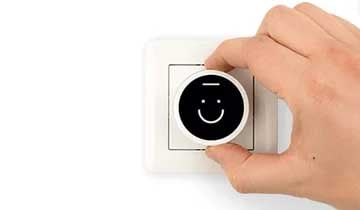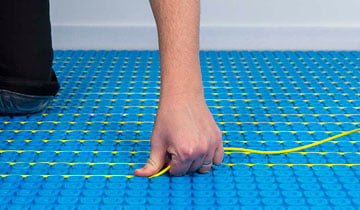8 min read
7 tips before buying electric underfloor heating
If you are in the market for an electric underfloor heating system for your next home renovation, then you have landed in the perfect place. We’ve...

When it comes to controlling your electric underfloor heating there are things you should do to get the most out of it. Unfortunately, we see a few things you shouldn’t do which will cause your electric underfloor heating to be much less efficient and ultimately cost you more to run.
In this electric heating blog, we’ve broken down some common mistakes made with thermostats in three sections. Buying, installing (+ setting up) and using. But don’t worry, we will also be giving expert advice to help you avoid making the same mistakes with your electric underfloor heating thermostat.
Choosing the wrong type of thermostat
Gone are the days when you could only buy thermostats with a dial which you just turned to adjust your heating. Now you’ll find thermostats that claim to save you hundreds off your heating bill as well as being controlled with a few spoken words via Alexa. However, it can be a false economy if you have no intention of using the features that smarter thermostats have to offer. If that’s the case a standard programmable will do the job and do it well.
Lot 20 Compliance
You might be asking yourself ‘why does this matter?’, but it is one of the key things to know which will ultimately help boost the performance of your electric underfloor heating system.
Back in 2018 LOT 20 was introduced. It’s a piece of legislation which comes from the European Ecodesign Directive and was a significant change within the electric heating industry. The purpose of the directive was to provide a framework for all energy-using products to adhere to which would help drive a reduction in wasted energy and meet carbon reduction targets.
In the UK, it’s almost impossible to come across a thermostat that isn’t Lot 20 compliant, but some do slip through the net. You’ll find more often than not, manual thermostats are not Lot 20 Compliant, so go for a thermostat with a programmable heating schedule at the very least.
Location of the thermostat
When you are installing your thermostat, the correct location will help you to run your heating system more efficiently. Thermostats use the temperature readings provided by a floor (and/or) air sensor to determine when your electric underfloor heating should be on or off. These readings are incredibly important when it comes to setting your ‘setback temperature’. More about setback temperatures later.
On average, thermostats should be installed around 5 feet (1.2m) from the floor and away from windows, direct sunlight and other heat sources, as this will help to ensure the temperature readings represent the whole room.
Air & Floor temperature sensing
Air temperature sensors are built into the thermostat, whereas the floor temperature sensor is installed within the floor build-up when the electric underfloor heating is being installed.
A key reason to use the floor sensor rather than the air sensor is to protect the floor finish. Different types of flooring will have a ‘safe maximum temperature’. Anything above the maximum temperature can damage the floor finish, which is more common with wood, carpet and vinyl than tiled floors. Using a floor sensor is also common if your electric underfloor heating system is used as a secondary heat source or you just want to take the chill away from cold tiles.
Air or ambient sensing is used more frequently if your electric underfloor heating is being used as a primary heat source for the room and we always recommend that the floor sensor is also enabled so that the maximum floor temperature can be limited.
What temperature should you set your thermostat to?
Firstly, the higher the floor temperature, the longer your heating will be on. Changing the temperature on your thermostat does not affect the power output of your heating. However, as mentioned previously, the ‘safe maximum temperature’ for your floor finish should not be exceeded.
Tile and stone floor finishes are the best for underfloor heating because they have great thermal conductivity and because of this in theory you could set the floor temperature a little higher to around 29oC. For all other floor finishes, we recommend a floor temperature to a maximum of 27oC, but you should always check with the floor finish manufacturer. Bear in mind that in a well insulated environment you shouldn’t need the floor temperature to exceed 22-24oC.
Not using a setback temperature
What is a setback temperature? It’s the temperature that your underfloor heating thermostat will ‘fall back’ to when you do not want your heating on. When you use a setback temperature, your heating will never fall below that temperature, no matter the programme you have in place. Using a setback temperature rather than turning off the heating completely is a great way to protect your home from very low temperatures. A setback temperature also boosts overall heating efficiency by reducing the amount of work your heating must do to maintain a comfortable temperature during the scheduled ‘on’ times.
However, a setback temperature doesn’t mean the heating is always on. If the setback temperature is correct for your home, the heating will be off whilst you’re out but protected from dropping too far if the weather suddenly turns very cold.
Turning up the thermostat to heat the room faster
It’s a myth that turning up your thermostat will heat the room faster. It’s simply not the case. A thermostat is designed to maintain a certain temperature within the room when the heating is on, adjusting the temperature has no effect on the power output. If the underfloor heating thermostat is set to 22oC, as an example, the underfloor heating will run at full power until it reaches that temperature. It will then switch off and on, to maintain the temperature.
Turning up the thermostat to heat the room faster will only result in the heating being on for a longer period, to reach the higher temperature. It won’t heat the room any quicker.
Keeping the heating on constantly
We’ve covered the importance of setback temperatures which enhances energy-efficiency rather than keeping your heating on constantly if you’re out because, let’s face it, nobody wants to come back to a cold home.
In most cases, leaving the thermostat temperature constant is aimed at keeping the heat inside your home at a preferred level. This means in the colder months your home will most likely be warmer than the outside even when you are not there.
The way heat travels is naturally from a place of high concentration to a place of lower concentration. Heat is transferred from a region of high concentration to a region of low concentration. The higher the temperature difference between the two points, the greater the potential for heat loss to the surrounding area. So, when it comes to home heating in the winter months, the higher the difference between the temperature inside compared to the outside, the more energy can leak out. This means maintaining the level of warmth inside the home takes more energy when it’s colder, and that means it costs more of your money to keep warm.
So, hopefully you can see why setback temperatures, which were previously mentioned are a better option. Most programmable thermostats will help you to avoid energy waste, making sure that ensuring you come back to a warm home that’s been running efficiently in your absence.
If you have a question about buying, selling or installing electric underfloor heating thermostats, please contact one of the ThermoSphere team who will be happy to help.
Complete the short form and you'll receive a fast quote turnaround time along with the right product details for your property or project.
Need it even quicker? Call our HQ and one of the team will be happy to help on 0800 019 5899.

8 min read
If you are in the market for an electric underfloor heating system for your next home renovation, then you have landed in the perfect place. We’ve...

18 min read
After the success of our ‘The top 5 electric underfloor heating brands for 2022?’ blog, we thought it would only be right to update it for 2023 and...

5 min read
With the heating season just around the corner, and one of the busiest times of the year for any heating manufacturer, we thought it would be a good...